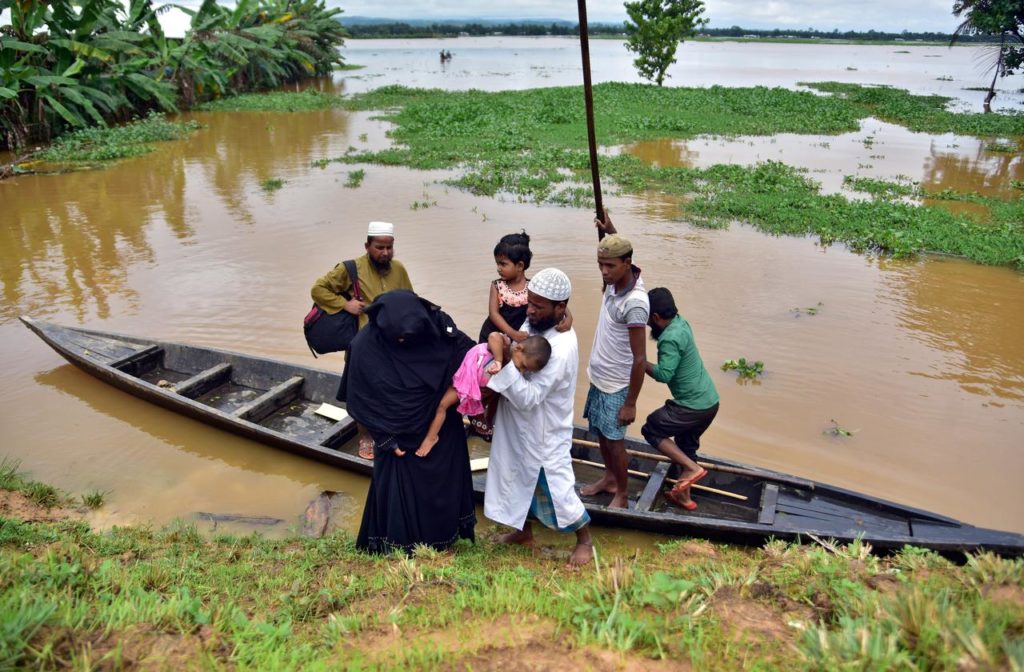Climate Change, Poor Planning Behind Assam’s Mounting Flood Ferocity
Jul 5, 2022 | Pratirodh Bureau
Flood-affected villagers disembark a boat at Kachua village in Assam's Nagaon district
Every year, around this time, life comes to a complete standstill in Assam, pounded by relentless rain and subsequent landslides and floods, the intensity of which have only been on the rise, leading to increased loss of lives and property.
Experts have pointed out that floods in the two river basins of Brahmaputra and Barak have occurred since yore but the unprecedented destruction witnessed in the recent years can be primarily attributed to faulty flood control measures, population pressure, shrinkage of water-bodies, unregulated construction and skewed development strategies.
Environmental scientist Dr Partha Jyoti Das told PTI that the devastating floods in May and June have taken larger swathes under its grip this time, when compared to the last few years, and the toll registered in the early-monsoon deluge has not been this high in recent memory.
Growing population and construction in flood-prone areas are some of the reasons behind the burgeoning damage in the state. In several places, breach of embankments has caused widespread destruction. Add to that frequent flash floods and that leaves people with little time to protect life and property, he explained.
Flood predictions and early warnings do not reach the vulnerable population on occasion, thus giving them no scope for preparations, the environmentalist said.
“Drainage congestion in low-lying areas, which is a result of rapidly changing land use practices, fast pace of urbanisation and expansion of human habitat all around, at the cost of natural waterways, have also intensified the flood situation,” Das insisted.
The current wave of floods, which the northeastern state is still reeling under, has claimed 174 lives, besides damaging crops across 2,35,845.74 hectares and leaving 90 lakh people in the lurch, according to a spokesperson of the Assam State Disaster Management Authority (ASDMA).
An official of the Water Resources Department noted that the Brahmaputra basin is among the most flood-prone areas in the world, followed closely by the Barak, and with nearly 100 tributaries and sub-tributaries feeding them, the two rivers make 40 per cent of Assam vulnerable to deluge.
“A series of factors, both natural and anthropogenic, add to the woes,” he said.
Highly potent monsoons, seismic activities leading to a change in the course of the river and rise in the river bed, and the unique geo-environmental setting of the rivers, particularly the Brahmaputra basin in the Eastern Himalayas, are some of the reasons why the flood situation keeps deteriorating in Assam, the official added.
Urban flooding in places such as Silchar, Guwahati, Dibrugarh, Barpeta, Nalbari and Tinsukia have also laid bare the faults in the drainage system of the state.
Drainage congestion and choking of local water bodies, which had earlier served as an outlet for flood waters, are largely responsible for urban flooding, river specialist Pradip Pujari told PTI.
Echoing him, Assam University’s former professor of environmental science Dr Abhik Gupta said hill cutting and deforestation, along with climate change, compound flood problems.
Das said a combination of strategies is being discussed by authorities to find a permanent solution.
Water Resources engineers have always advocated the construction of large storage reservoirs but this is fraught with risk, considering the geo-ecological fragility of the region, he maintained.
Non-structural measures like issuance of flood warnings can play an important role in reducing damages. Use of geo-synthetics for fortifying embankments is also being considered as an option, he said.
Das, however, asserted that people might still have to put up with floods, at least to a certain extent, despite the adoption of all possible measures to minimise the scourge, as technological fixes have certain limitations against natural processes.
“Reducing vulnerability and enhancing resilience while taking into account the impact of climate change should be at the core of flood management along with the exploration for a feasible technological solution,” he added. (PTI)
